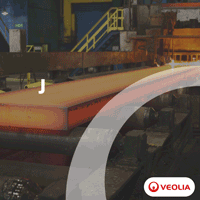worldsteel Provides Short Range Outlook for Apparent Steel Use
04/22/2010 - The World Steel Association is forecasting that apparent steel use will increase to 1,241 million tonnes in 2010, a 10.7% increase following a 6.7% contraction in 2009.
The World Steel Association (worldsteel) is forecasting that apparent steel use will increase by 10.7% to 1,241 million tonnes in 2010, following a 6.7% contraction in 2009.
|
Short range outlook for apparent steel use,
finished steel (2009-2011) |
|||
|
Regions |
Projected Growth Rates, %
|
||
|
2009 (e)
|
2010 (f)
|
2011 (f)
|
|
|
European Union (27)
|
-35.2%
|
13.7%
|
7.9%
|
|
Other Europe
|
-12.5%
|
13.5%
|
11.9%
|
|
C.I.S.
|
-28.2%
|
11.0%
|
8.0%
|
|
N.A.F.T.A.
|
-37.4%
|
23.5%
|
7.2%
|
|
Central & South America
|
-24.1%
|
20.0%
|
6.7%
|
|
Africa
|
9.6%
|
8.6%
|
9.3%
|
|
Middle East
|
-8.0%
|
10.0%
|
8.2%
|
|
Asia & Oceania
|
8.7%
|
8.4%
|
3.9%
|
|
World
|
-6.7%
|
10.7%
|
5.3%
|
|
- China
|
24.8%
|
6.7%
|
2.8%
|
|
- BRIC
|
17.5%
|
8.0%
|
4.1%
|
|
- MENA
|
0.8%
|
9.5%
|
8.4%
|
|
- World excl. China
|
-24.5%
|
14.4%
|
7.4%
|
|
- World excl. BRIC
|
-26.8%
|
14.3%
|
6.7%
|
The increase, projected as part of worldsteel’s short range outlook (SRO) for 2010 and 2011, means that world steel demand in 2010 will exceed pre-crisis levels of 2007. In 2011, it is forecast that world steel demand will grow by 5.3% to reach a historical high of 1,306 million tonnes.
The resilience of the emerging economies, especially China, has been the critical factor enabling the earlier-than-expected recovery of world steel demand. However, the risk of increased volatility of raw material prices — which could not be fully considered before the worldsteel Economics Committee met in Beijing in March — remains a major concern to the steel industry and its customers.
“The general picture is an improvement on the forecast we issued in October last year,” said Daniel Novegil, Chairman of the worldsteel Economics Committee. “The world steel industry now seems firmly set on a path to recovery. The emerging economies, who in total maintained positive growth through the crisis, will continue to show strong growth, driving world steel demand in the future, however the current recovery in the major developed economies is slower and the projected steel demand for them in 2011 is well below the 2007 level.”
“The recovery is not only earlier but also stronger than expected,” continued Novegil. “It was driven in large part by government stimulus packages and recent inventory restocking. The real concern will be how post-crisis macroeconomic policies deal with fiscal balancing and inflationary pressures”.
According to worldsteel’s outlook, China’s apparent steel use is expected to increase by 6.7% in 2010 to 579 million tonnes; this follows a 24.8% increase in 2009. The group speculates that that apparent steel use could be even higher than this forecast based on the pace of economic growth and steel production seen in the 1st quarter of 2010. In 2011, the growth rate is expected to slow to 2.8%, which would bring China’s apparent steel use to 595 million tonnes. China is expected to account for 45.5% of world apparent steel use in 2011, which compares to 48.4% in 2009.
India’s steel demand, which maintained stable growth during the crisis, is expected to grow by 13.9% and 13.7% in 2010 and 2011 respectively, after a growth rate of 7.7% in 2009. In 2011, India’s apparent steel use is expected to reach 71.6 million tonnes.
In the NAFTA region, the U.S. recorded apparent steel use of 57.4 million tonnes in 2009, representing a decrease of 41.6%. With the recovery in the U.S. economy and stock rebuilding, apparent steel use is expected to grow by 26.5% in 2010 and then by 7.5% in 2011 to 78.1 million tonnes, bringing apparent steel use back to the level of 1991. For NAFTA, the level of apparent steel use that is expected in 2011 is similar to that of 1993.
|
The Short Range Outlook is provided by the worldsteel Committee on Economic Studies, which meets twice a year. The Committee considers country and regional demand estimates to compile a global overview on apparent steel use (ASU).
Committee membership comprises chief economists from more than 40 of the worldsteel member companies.
The forecast projections consider both real and apparent steel use. Apparent steel use reflects the deliveries of steel to the marketplace from domestic steel producers as well as from importers. The Committee considers country and regional demand estimates in order to compile its global overview on apparent steel use.
Real steel use, in contrast, takes into account steel delivered to or drawn from inventories.
The Short Range Outlook is presented to the Board for their final review before publication.
|
Japan, which experienced a 31.7% fall in apparent steel use in 2009, is expected to see its steel use increase by 10.3% in 2010. In 2011, however, Japan’s steel demand is expected to stagnate with -0.2% growth due to weakening of its major steel-using sectors. This brings Japan’s apparent steel use in 2011 to 58.6 million tonnes, the level achieved in 1983.
The CIS region was another major victim of the economic crisis due to its heavy dependence on oil revenue and foreign capital. Apparent steel use in the region fell 28.2% in 2009, with a fall of -41.9% in Ukraine. In 2010, apparent steel use in the CIS region is projected to grow by 11% and then by 8% in 2011.
Turkey, which experienced a 9.4% decline in apparent steel use in 2009, is expected to see an increase of more than 13% in 2009 and 2010.
The MENA region (Middle East and North Africa) continued to record positive growth in steel use in 2009 despite significant falls in UAE and Saudi Arabia. The region’s better-than-average performance, despite the decline in the oil price, is attributed to the strength of Egypt and Iran. According to worldsteel’s outlook, the MENA region is expected to maintain relatively resilient growth in 2010 and 2011 with apparent steel use reaching 68.2 million tonnes in 2011.
The World Steel Association (worldsteel), one of the largest and most dynamic industry associations in the world, represents approximately 180 steel producers (including 19 of the world's 20 largest steel companies), national and regional steel industry associations, and steel research institutes. worldsteel members produce around 85% of the world's steel.



-(220-x-200-px)-(130-x-130-px)-(220-x-200-px).jpg?lang=en-US&ext=.jpg)
.gif?width=200&height=200&mediaprotectionhash=ddb07947ad3b4ab959a83714461eccd5c6895f370695eb035a9ff7aa736f8ad9&ext=.gif)





